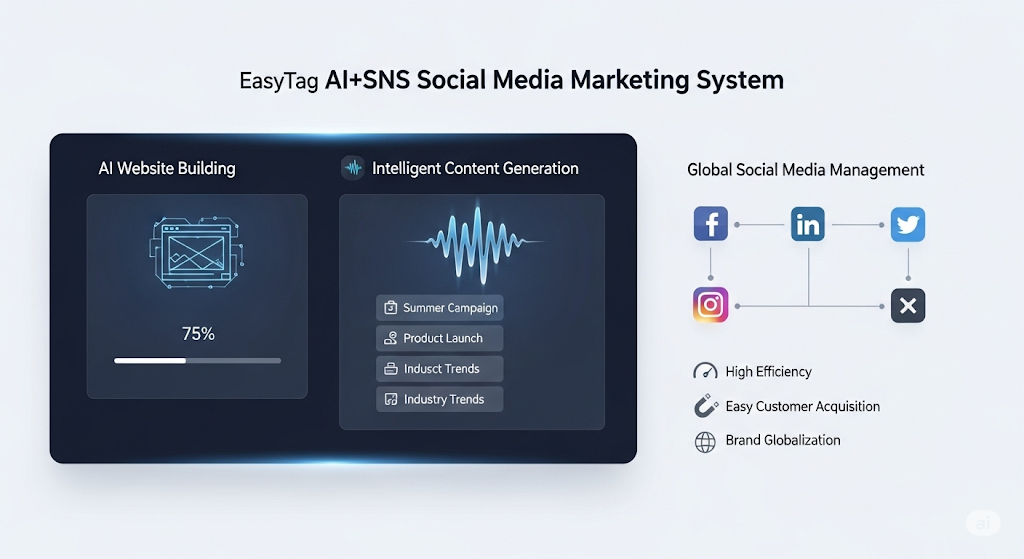- How much can AI-powered cross-border e-commerce website solutions improve conversion rates? Real data reveals the answer2025-12-11View Details
- Is it difficult to increase brand awareness? Effective strategies for 2024 + Recommended AI tool combinations2025-12-11View Details
- Data-Driven Advertising Boosts ROI by 50%? Real Case Analysis2025-12-11View Details
- The Secret to 3X Website Traffic Growth: AI + Localized Content Strategy2025-12-11View Details
- Can localized content really improve conversion rates? Proven results from the European market2025-12-11View Details
- Does website acceleration affect conversion rates? The 2024 loading speed standards have been updated.2025-12-11View Details
- Why is your data-driven advertising ineffective? 90% of companies overlook this step2025-12-11View Details
- How can distributors quickly build localized foreign trade websites? AI website solutions are here2025-12-11View Details
Global Multi-node Servers: The Ultimate Solution to Reduce Bounce Rate from 70% to 26% for Foreign Trade Independent Websites
Is slow website loading causing a poor user experience? Global multi-node servers increase access speeds by 40% and significantly reduce bounce rates through intelligent scheduling and content distribution.
In today's era of global digital trade, independent websites for foreign trade have become a crucial gateway for businesses expanding internationally . However, many businesses find that no matter how they optimize their website design and content, they can't effectively reduce their stubbornly high bounce rates. According to industry data, the average bounce rate ranges from 26% to 70% , with a rate above 46% considered "high," which directly impacts a company's inquiry conversion rate and customer acquisition costs . One of the core pain points contributing to this problem is slow website loading speeds and a poor user experience. Global multi-node servers are the ultimate solution to this problem.

1. High bounce rate: the invisible killer of foreign trade independent stations
A website's bounce rate, which refers to the percentage of users who leave a website after viewing only one page, is a key indicator of website engagement and user experience. Statistics show that the average bounce rate for independent foreign trade websites ranges from 41% to 55% , with an ideal range of 26% to 40% . However, many foreign trade websites experience bounce rates far exceeding this level, sometimes exceeding 70%.
A high bounce rate means potential customers are leaving your website quickly after entering it, which not only wastes advertising investment but also means lost potential business opportunities. When users enter your website through Google search or ads, but immediately leave due to slow loading or poor experience, your business not only loses the conversion opportunity, but also potentially loses this potential customer forever .
There are many factors that contribute to high bounce rates , including unattractive website content, misleading titles and descriptions, and broken links. However, one of the most critical factors is slow website loading speed . Users typically browse websites in fragmented time, and if a website fails to load within three seconds, most users will simply close it . Furthermore, search engines like Google also consider website speed a key ranking factor. Slow-loading websites, even with significant investment in SEO and advertising, struggle to achieve good rankings and visibility .
2. Speed and Experience: The Technical Principles of Global Multi-node Servers
Global multi-node servers are a technology architecture that distributes the storage and delivery of website content by deploying server nodes across every continent. When a user accesses a website, the system automatically identifies the user's geographic location and dispatches the request to the nearest server node, significantly improving access speed .

Static content (such as images, CSS, and JavaScript files) is cached on globally distributed edge nodes. When users request these resources, they can quickly retrieve them from the nearest node, avoiding the delays caused by long-distance transmission . Dynamic content is transmitted over the optimal path through intelligent routing, reducing the impact of network congestion on speed.
The multi-node architecture automatically distributes traffic load, preventing performance degradation caused by overloading a single server. If a node fails, the system automatically switches user requests to other available nodes, ensuring high website availability .
Tested data shows that by deploying a global multi-node server, average website loading speeds in different regions can be increased by over 40% , SEO scores can be improved by 35%, average bounce rates can be reduced by 22%, and conversion rates can be increased by 18% . For example, Yiyingbao deploys server clusters across seven continents, combined with AWS and Alibaba Cloud CDN acceleration, significantly increasing the loading speed of its independent sites and significantly improving the user experience .
This technical architecture is particularly suitable for foreign trade companies targeting multiple markets. For example, a company serving the European, American, Middle Eastern, and Southeast Asian markets can use server nodes in the United States, Germany, Singapore, and other locations to ensure that users in all regions receive a consistent and fast experience.
3. Practical Effect: How Multi-node Servers Solve the Problem of High Bounce Rate
Global multi-node servers directly address the root causes of high bounce rates from the following specific aspects:

Traditional single-server deployments often face physical distance limitations. For example, a website hosted in the US might require users in Asia to cross the Pacific Ocean, resulting in hundreds of milliseconds of latency. However, global multi-node servers, through localized deployment, deliver content to users close to home, minimizing latency . A machinery manufacturing company using the Yiyingbao system saw access times for European and American users reduced from over five seconds to under two seconds after deploying a global multi-node system, significantly reducing bounce rates .
4. Beyond Speed: Comprehensive Benefit Evaluation of Multi-Node Servers
Speed optimization directly leads to increased conversions. Data shows that reducing loading time from 3 seconds to 1 second can increase conversion rates by more than 30%.

5. Implementation Guide: How to Effectively Deploy Global Multi-Node Servers
6. Success Stories: How Companies Achieve Breakthroughs Through Global Multi-Node Servers
VII. Future Trends: Technological Evolution in Globalized Digital Trade

Artificial intelligence technology will play a greater role in server scheduling. By predicting user behavior and traffic patterns, resources can be allocated and content preloaded in advance, achieving an "instant-on" experience . The Yiyingbao system has begun integrating AI prediction algorithms, which can predict peak traffic times in different regions based on historical data and automatically adjust resource allocation .
With the widespread adoption of 5G, edge computing will deliver an even more extreme performance experience. Websites will not only cache content on edge nodes but also offload some computing tasks to the edge of the network, further reducing latency . This integration is particularly well-suited for emerging interactive scenarios like AR/VR, providing overseas buyers with a more immersive product experience.
In the future, our global multi-node servers will place greater emphasis on balancing security and performance, providing comprehensive protection without sacrificing speed through built-in security capabilities. This includes advanced features such as real-time threat detection and automatic malicious traffic cleaning .
Data center energy consumption is a growing concern. The next generation of global network architectures will prioritize energy efficiency optimization, maximizing resource utilization through intelligent scheduling and reducing carbon footprints . This will not only enhance corporate social responsibility (CSR) but also reduce operating costs.
Global multi-node servers are a key technical solution for addressing high bounce rates on independent foreign trade websites. Through distributed deployment and intelligent scheduling, they effectively mitigate latency issues caused by physical distance, significantly improving website loading speeds and user experience. Case studies have shown that properly deploying multi-node servers can reduce website bounce rates from a high of 70% to an ideal 26% , while significantly improving conversion rates and SEO performance.

In the era of globalized digital trade, website performance has become a critical factor influencing the success or failure of foreign trade companies' overseas expansion. Investing in a global multi-node server is not only a technological upgrade, but also a crucial business decision. As technology continues to evolve, companies should closely monitor the latest trends and continuously optimize their website architecture to maintain their leading position in the fierce international competition.
Related articles
Related products

















